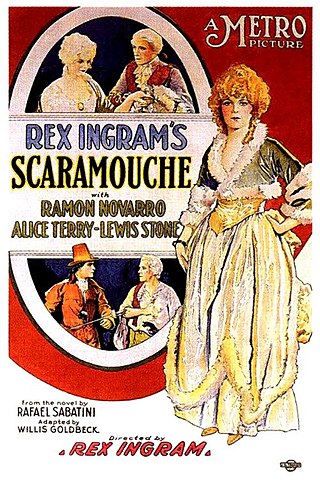Related Research Articles

The Black Pirate is a 1926 American silent action adventure film shot entirely in two-color Technicolor about an adventurer and a "company" of pirates. Directed by Albert Parker, it stars Douglas Fairbanks, Donald Crisp, Sam De Grasse, and Billie Dove. In 1993, The Black Pirate was included in the annual selection of 25 motion pictures to be added to the National Film Registry of the Library of Congress, being deemed "culturally, historically, or aesthetically significant."

The Great Train Robbery is a 1903 American silent film made by Edwin S. Porter for the Edison Manufacturing Company. It follows a gang of outlaws who hold up and rob a steam train at a station in the American West, flee across mountainous terrain, and are finally defeated by a posse of locals. The short film draws on many sources, including a robust existing tradition of Western films, recent European innovations in film technique, the play of the same name by Scott Marble, the popularity of train-themed films, and possibly real-life incidents involving outlaws such as Butch Cassidy.

Silent comedy is a style of film, related to but distinct from mime, developed to bring comedy into the medium of film during the silent film era (1900s–1920s), before synchronized soundtracks that could include dialogue were technologically available for the majority of films. While silent comedy is still practiced today, albeit much less frequently, it has significantly influenced modern comedic media.

Wanderer of the Wasteland is a 1924 American silent Western film directed by Irvin Willat and starring Jack Holt, Noah Beery, and Billie Dove. It was the second feature film to be photographed entirely in two-color Technicolor.

Scaramouche (1923) is a silent swashbuckler film based on the 1921 novel Scaramouche by Rafael Sabatini, directed by Rex Ingram, released by Metro Pictures, and starring Ramon Novarro, Alice Terry, Lewis Stone, and Lloyd Ingraham.

The Flag: A Story Inspired by the Tradition of Betsy Ross is a 1927 MGM silent fictionalized film short in two-color Technicolor, about the making of the U.S. flag by Betsy Ross. It was the first of the "Great Events" series co-produced by Technicolor and Colorcraft Pictures Inc., and distributed by Metro-Goldwyn-Mayer. The basically true story is combined with a completely fictional subplot in which a British soldier crosses enemy lines to visit his wife, a friend of Betsy Ross.

Technicolor is a family of color motion picture processes. The first version, Process 1, was introduced in 1916, and improved versions followed over several decades.
Climbing the Golden Stairs is an American 2-reel musical fantasy short released in 1929. It was produced in 2-color Technicolor dye-transfer process.
The Lady of Victories is a 1928 MGM silent fictionalized film short in two-color Technicolor. It was the third short film produced as part of Metro-Goldwyn-Mayer's "Great Events" series.
The Czarina's Secret is a 1928 MGM silent fictionalized film short in two-color Technicolor. It was the fourth film produced as part of Metro-Goldwyn-Mayer's "Great Events" series.
The Virgin Queen is a 1928 MGM silent fictionalized film short in two-color Technicolor. It was the third short film produced as part of Metro-Goldwyn-Mayer's "Great Events" series.
Cleopatra is a 1928 MGM silent fictionalized film, shot in two-color Technicolor. It was the sixth short produced as part of Metro-Goldwyn-Mayer's "Great Events" series.
The Heart of General Robert E. Lee is a 1928 MGM short silent fictionalized film short in two-color Technicolor. It was the seventh film produced as part of Metro-Goldwyn-Mayer's "Great Events" series.
Madame du Barry is a 1928 MGM short silent fictionalized film short in two-color Technicolor. It was the eighth film produced as part of Metro-Goldwyn-Mayer's "Great Events" series, and the last to be released before the new year.

The Fire Fighters is a Mickey Mouse short animated film first released on June 20, 1930, as part of the Mickey Mouse film series. It was the nineteenth Mickey Mouse short to be produced, the fourth of that year.
Manchu Love is a 1929 American pre-code Hollywood Metro-Goldwyn-Mayer short silent historical fiction film short in two-color Technicolor. The film features a cast entirely of people of Asian descent and stars Sojin as Su Shun and Etta Lee as Empress Tzu Hsi. It was the ninth film produced as part of Metro-Goldwyn-Mayer's "Great Events" series.
Light of India is a 1929 MGM short silent film short in two-color Technicolor. It was the tenth film produced as part of Metro-Goldwyn-Mayer's "Great Events" series.
A Princess of Destiny is a 1929 MGM short silent film short in two-color Technicolor. It was the eleventh and penultimate film produced as part of Metro-Goldwyn-Mayer's "Great Events" series.
Frontier Romance is a 1929 MGM short silent film short in two-color Technicolor. It was the twelfth and final film produced as part of Metro-Goldwyn-Mayer's "Great Events" series. A romantic historical drama, the film depicts George Rogers Clark and other American colonists as they interact with Native American tribespeople.